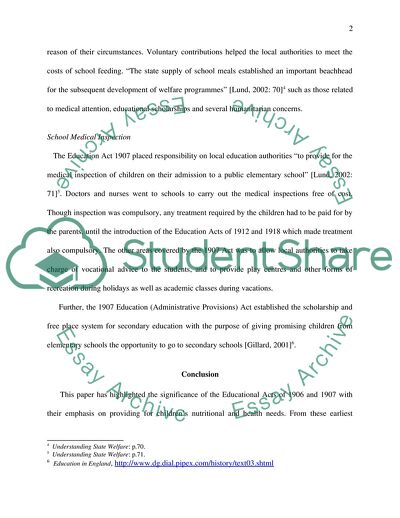
- Home
- Free Samples
- Premium Essays
- Editing Services
- Extra Tools
- Essay Writing Help
- About Us
- Studentshare
- Subjects
- Miscellaneous
- From Poverty to Social Exclusion: An Introduction to Social Policy
From Poverty to Social Exclusion: An Introduction to Social Policy - Essay Example

- Subject: Miscellaneous
- Type: Essay
- Level: Undergraduate
- Pages: 4 (1000 words)
- Downloads: 0
- Author: alana30
Extract of sample "From Poverty to Social Exclusion: An Introduction to Social Policy"
The 1906 Education Act for provision of meals and the 1907 Education Act for the provision of medical inspection in schools were followed by legislation strengthening the law protecting children from cruelty and neglect, and legislation “publicly emphasizing the social rights of the child” [Frost, 2005: 279]2. The cost of providing meals for elementary school children who were otherwise unable to make use of the provision of education due to lack of food, was met by the Local Education Authorities.
Those parents who could afford to pay the subsidized cost of the meal, were charged the nominal amount of one penny or a halfpenny [Wardle, 1977]3, while most did not pay by reason of their circumstances. Voluntary contributions helped the local authorities to meet the costs of school feeding. “The state supply of school meals established an important beachhead for the subsequent development of welfare programmes” [Lund, 2002: 70]4 such as those related to medical attention, educational scholarships and several humanitarian concerns.
The Education Act 1907 placed responsibility on local education authorities “to provide for the medical inspection of children on their admission to a public elementary school” [Lund, 2002: 71]5. Doctors and nurses went to schools to carry out the medical inspections free of cost. Though inspection was compulsory, any treatment required by the children had to be paid for by the parents, until the introduction of the Education Acts of 1912 and 1918 which made treatment also compulsory. The other areas covered by the 1907 Act was to allow local authorities to take charge of vocational advice to the students, and to provide play centres and other forms of recreation during holidays as well as academic classes during vacations.
Further, the 1907 Education (Administrative Provisions) Act established the
...Download file to see next pages Read MoreCHECK THESE SAMPLES OF From Poverty to Social Exclusion: An Introduction to Social Policy
Social Exclusion in Relation to Social Housing
Housing and the Inclusive Society
Poverty is About Lack of Participation, Not Just Lack of Income
Poverty and Social Exclusion
Policies in Reducing the Process of Social Exclusion
Poverty, Social Inclusion, and Social Work
Poverty is about Lack of Participation, not just Lack of Income
Poverty and Social Seclusion

- TERMS & CONDITIONS
- PRIVACY POLICY
- COOKIES POLICY